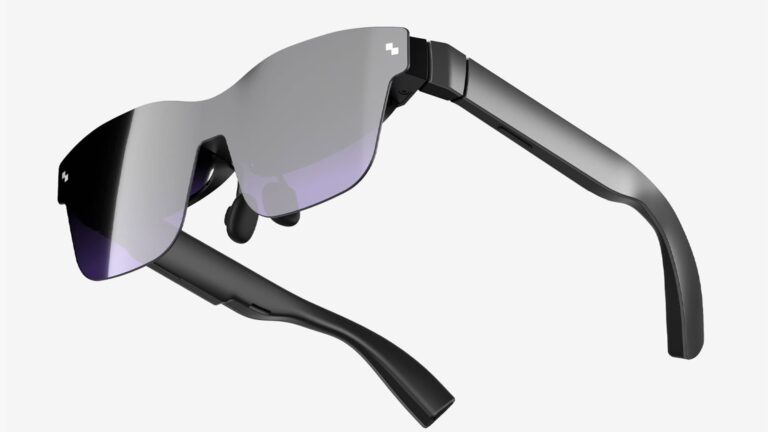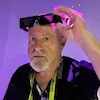
The last six months – including CES – have seen an inflection in new smart glasses. Eschewing the idea that faceworn wearables have to offer Magic-Leap style dimensional graphics or Hololens2-style jack-of-all-trades capabilities, these smart glasses are simpler, focused, and stylistically viable. For example, last week, we examined Xreal Air 2’s screen-extending capabilities. The week before that, we looked at Solos AirGo 3 and its reliance on AI rather than complex visuals. The surprise-success Ray-Ban Meta Smartglasses carry a similar torch.
Now we move to a device that similarly leans on a focused screen-extension use case: TCL’s RayNeo Air 2. In fact, it has restored my faith in the potential of AR glasses to deliver a big screen experience in a light, portable form that just works when you plug its C-connection into any compatible device. The screen is big and bright and looks crisp even in sunlight. The RayNeo Air 2 is the best-looking of its peers, too, but is still just a bit too bulky to be mistaken for sunglasses.
Screen extenders were all the rage at CES 2023 in January, but they’re just hitting the market this fall. It seemed AR is going to enter the lives of most consumers as a pricey smartphone accessory optimized to deliver a big-screen experience, but it hasn’t happened yet. And simulating a big screen is all these do. It is all they will ever do, so looking and sounding great is their one and only job. We should not be surprised that China’s TCL, which has been making low-cost TVs for decades, has gotten this part right.
The $379 RayNeo Air 2 weighs just 76 grams while housing a pair of 16:9, 120Hz Sony Micro-OLED 1080p displays that are equivalent to a 201-inch screen viewed from six meters away. The glasses have a respectable 46° FOV, 49 pixels-per-degree (PPD), and a 108% sRGB color gamut. It also features what they call “a fully upgraded dynamic stereo sound system, complete with a whisper mode for privacy.” The sound is good, but not great. Audio smart glasses like Bose Frames spend their money on audio. TCL spent their money on displays. I say they made a good call here. Whisper mode is a nice touch, though.
My biggest beef with every other pair of AR smart glasses is that I can’t get them to sit correctly on my face. They all have adjustable nose pads, but those alone don’t do it. The RayNeo Air 2 is the only one that fits me. This is because it has a special hinge where the wing meets the frame, which allows you to adjust the angle. It seems like a detail, but together with a bright, crisp screen, it makes all the difference.
Now the not-so-good part. The RayNeo Air 2 supports DisplayPort or USB-C Alt mode only. For older iPhones with the Lightning port and other devices that don’t support USB-C Alt mode, you will need a $99 MiraScreen Adapter. Be sure to check for compatibility lest you make a critical shopping mistake.
If you or someone on your list has an iPhone 15, the RayNeo Air 2 is going to make their day. A lot of thought has gone into these. It feels good to wear them.
 Charlie Fink is the author of the AR-enabled books “Metaverse,” (2017) and “Convergence” (2019). In the early 90s, Fink was EVP & COO of VR pioneer Virtual World Entertainment. He teaches at Chapman University in Orange, CA. Follow him on Twitter or LinkedIn, and check out his website or other work.
Charlie Fink is the author of the AR-enabled books “Metaverse,” (2017) and “Convergence” (2019). In the early 90s, Fink was EVP & COO of VR pioneer Virtual World Entertainment. He teaches at Chapman University in Orange, CA. Follow him on Twitter or LinkedIn, and check out his website or other work.






